Speedier Software Upgrades For Army Vehicles: Open Architecture
Posted on
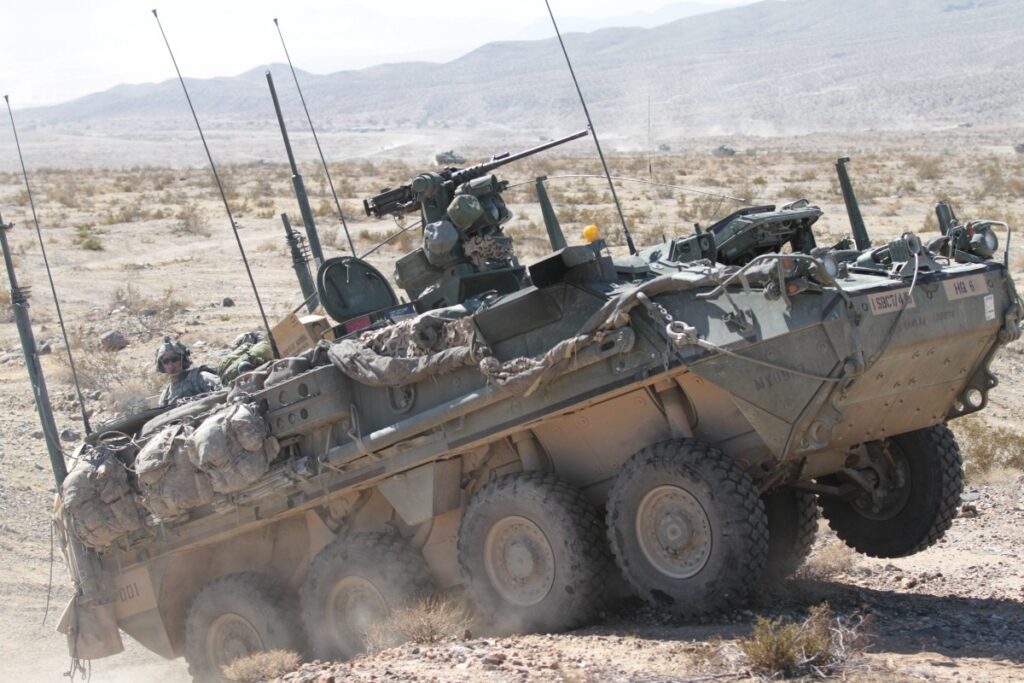
Army vehicles like this Stryker are often festooned with different antennas, each for a different radio or GPS system. Open architecture aims to streamline such systems.
NATIONAL PRESS CLUB: The Army’s wheeled vehicle programs like Stryker and JLTV are leading it on the path to open architecture, a modular approach to designing software and electronics that makes them easier to upgrade. That’s particularly critical when, facing Russian GPS jamming, the Army is looking to improve Position, Navigation & Timing (PNT) on tens of thousands of vehicles.
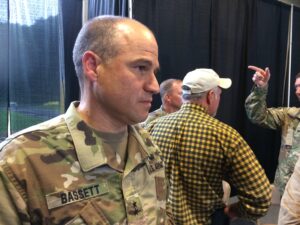
Maj. Gen. David Bassett
“The killer use case for this, at least initially, is distributing Position, Navigation and Timing across our platforms,” said Maj. Gen. David Bassett, the Army’s Program Executive Officer for armored fighting vehicles like Strykers and tanks. The idea is to invent an “Assured PNT” solution once and then install it, plug-and-play, across a wide variety of vehicles that all use the same open architecture. “The savings associated with that, as opposed to modernizing every GPS receiver on your platforms (individually), is enormous,” Bassett told the Open Architecture Summit here.
To give a sense of scale: Across the Defense Department as a whole, there are 260 different, proprietary, and often incompatible configurations of GPS and inertial navigation equipment, another participant said. And the Army has many more ground vehicles to upgrade than the other services have aircraft or ships, with over 4,000 Strykers in service alone.
The eight-wheel-drive Stryker is the first of Bassett’s programs to move to an Army open architecture called VICTORY. (It’s an awful nested acronym: Vehicular Integration for C4ISR/EW Interoperability). VICTORY comes along with the installation of an in-vehicle Ethernet and other improvements on what’s called the Stryker DVH (Double Vee Hull) A1. Other armored vehicles such as the M1 Abrams tank and M2 Bradley troop carrier will move to the VICTORY standard as part of future upgrade packages called ECPs (Engineering Change Proposals).
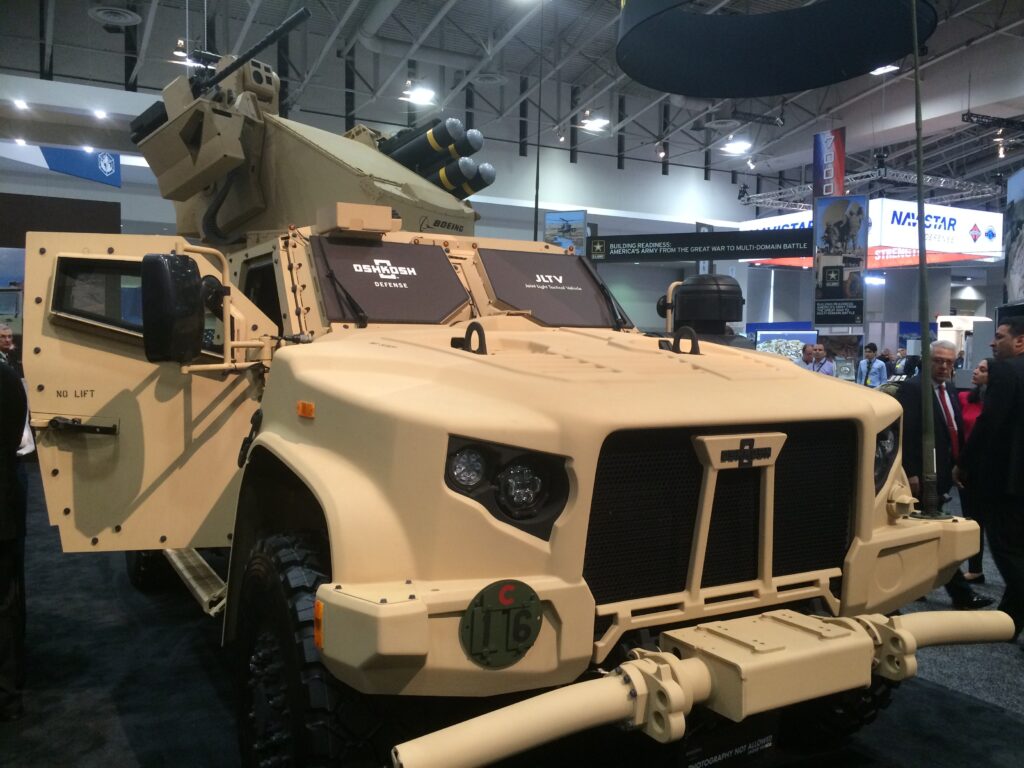
Oshkosh Joint Light Tactical Vehicle fitted with anti-aircraft missiles and machinegun.
Alongside the 8×8 Stryker is the smaller but, soon, much more numerous 4×4 Joint Light Tactical Vehicle, the 21st century Jeep. The planned buy of 50,000 JLTVs is meant to replace many (not all) of the military’s nimble but vulnerable Humvees and robust but lumbering MRAPs with a tactical truck that blends the best of both.
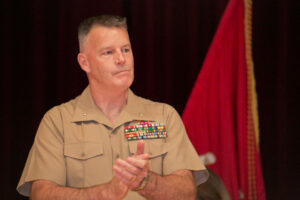
Then-Brig. Gen. Niels Nelson (now Maj. Gen.)
“It’s our great model for open architecture,” said Maj. Gen. Niel Nelson, the Marine Corps’ assistant deputy commandant for combat development. The whole point of a tactical utility vehicle like the JLTV, or the Humvee and Jeep before it, is that you can reconfigure it easily for different missions, he told the conference, from hauling cargo to evacuating casualties to conducting reconnaissance. In modern warfare, that means you need to reconfigure software and electronics quickly too.
“JLTV comes as sort of a base truck (that) could get any number of radios and jammers and weapons stations and all sorts of things,” said Scott Davis, the Army’s Program Executive Officer for combat support and service vehicles, who’s running JLTV for all the services. Thanks to open architecture, he told the conference, “what we’ve seen is the integration timeline and working thru the bugs and all of that is much, much quicker with the digital backbone that’s in the vehicle.” It’s possible to route information from multiple radios to a single screen, for example, rather than have a different display for each.
There have been hitches, the Army executives admitted. “To be very fair, adoption of VICTORY has been somewhat slow,” Bassett said bluntly at the start of his remarks.
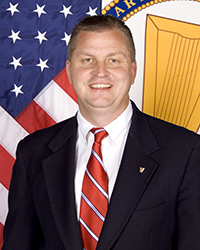
Scott Davis
So, added Davis, when JLTV solicited designs from industry in a formal Request For Proposal, “the first instantiation of the VICTORY standard wasn’t completely baked, but they rolled in pieces of it.” That means the VICTORY standard won’t be completely standard. Different programs that adopted it at different stages of maturity may have slightly different versions, although they can reconcile them over time.
More than any other service, Army faces tremendous problems of scale, which makes it hard to field one uniform standard across the service, said Rickey Smith, a retired colonel now with the Army Capabilities Integration Center. “The VICTORY architecture is a good start,” he said, but it’ll take years to roll it out across the service. “Everybody’s not going to have it (at once). Do it in increments, do it in blocks”.
Nor is VICTORY the all-conquering open architecture for all purposes, even in the relatively narrow world of Army vehicles. Bassett, for instance, is also working on a Modular Active Protection System (MAPS), that will set common standards for radars, jammers, and mini-missiles that defend armored vehicles from incoming weapons, allowing plug-and-play upgrades as threats evolve. Meanwhile Army aircraft programs are working with the Navy and Air Force on an open architecture for avionics known as FACE, the Future Airborne Capability Environment. The Air Force and Navy have their own open architectures as well — and there’s not been much work on making them compatible.
“There are these DoD (Department of Defense) systems, but I do not see effectively at the DoD level, the federal level, a body of government common standards to make sure things are open,” said Maj. Gen. Sarah Zabel, the Air Force’s director of IT acquisition process development. “It is possible that the open architecture the Air Force has might not be compatible entirely with the open architecture (another service) has.”
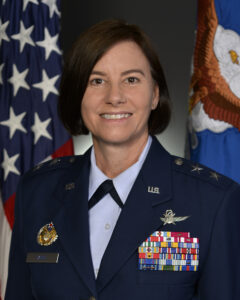
Maj. Gen. Sarah Zabel
That said, Zabel went on, “I would argue that the nature of open architecture means that the incompatibility’s not going to be as bad when every system’s completely unique.” In other words, there might be dozens of different standards, but that’s still a lot easier to deal with than hundreds of individual systems.
To some degree, you do need different forms of open architecture — different standards — for different missions, several experts at the conference said. Flight-critical electronics on an aircraft moving hundreds of miles per hour, for instance, have to operate with a speed and precision that would be expensive overkill on a ground vehicle moving 40 mph. Submarines, helicopters, and trucks all need to track different kinds of data in different ways.
“One open architecture standard does not rule them all,” said Marcell Padilla, a former Navy pilot who now works on Army programs for CRL Technologies. “We need to have a combination of them.”
Subscribe to our newsletter
Promotions, new products and sales. Directly to your inbox.
